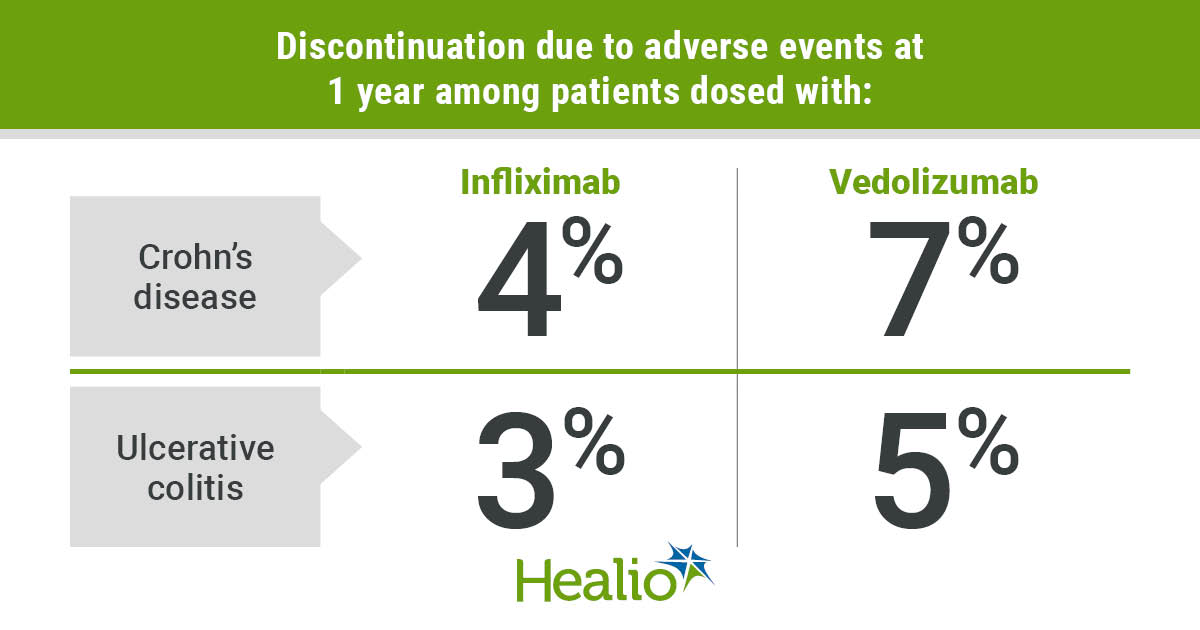April 10, 2024
2 min read

April 10, 2024
2 min read
Induction and maintenance treatment with infliximab was more efficacious than vedolizumab in patients with Crohn’s disease, while efficacy was similar between the two therapies in patients with ulcerative colitis, according to data.
“In a previous systematic review and meta-analysis, we performed an indirect comparison of infliximab and vedolizumab trials (both including IV and SC formulations) in adults with moderate to severe CD or UC; we showed that infliximab had better efficacy in the induction phase and comparable efficacy during the maintenance phase and a similar overall safety profile, compared with vedolizumab,” Laurent Peyrin-Biroulet, MD, PhD, professor of gastroenterology at Nancy University Hospital in France, and colleagues wrote in BMC Gastroenterology. “Given the potential benefits of SC over IV dosing observed in patients with rheumatoid arthritis, we conducted a comparative analysis of efficacy and safety outcomes with infliximab SC (CT-P13 SC) and vedolizumab (both IV and SC formulations) in patients with moderate to severe CD or UC.”

Researchers pooled data from three randomized controlled CD trials (CT-PI3 SC, GEMINI II and GEMINI III) and four randomized controlled UC trials (CT-P13, GEMINI I, VARSITY and VISIBLE I), with more than 1,200 participants per disease cohort assigned to subcutaneous infliximab (n = 53) or vedolizumab (n = 1,176).
Studied outcomes included the proportion of patients who achieved disease-specific clinical responses and remission, measured by Crohn’s Disease Activity Index for CD and total or partial Mayo scores for UC; or discontinuation due to lack of efficacy, as well as the proportion of patients who experienced adverse events, infections or discontinuation due to adverse events.
According to results, IV induction therapy with infliximab demonstrated better efficacy vs. vedolizumab, with non-overlapping 95% CIs (CDAI-70: 79% vs. 45%; CDAI-100: 62% vs. 36%; clinical remission: 49% vs. 17%).
During maintenance, a “numerically higher” proportion of patients achieved a CDAI-100 response (64% vs. 44%) and clinical remission (57% vs. 39%) in the subcutaneous infliximab group vs. the vedolizumab group, and fewer patients on infliximab discontinued therapy at 1 year due to lack of efficacy (5%; 95% CI, 1-28 vs. 38%; 95% CI, 30-46).
However, “similar proportions” of patients in each group experienced adverse events (76% vs. 78%), serious adverse events (9% vs. 16%), serious infections (4% vs. 4%) and discontinuation due to adverse events (4% vs. 7%).
Among UC patients, a similar proportion achieved clinical response or remission with subcutaneous infliximab and vedolizumab during both induction (clinical response: 77% vs. 69%; clinical remission: 34% vs. 40%) and maintenance phases (62% vs. 63%; 51% vs. 39%; mucosal healing: 56% vs. 49%).
A “numerically lower” proportion of patients treated with subcutaneous infliximab discontinued due to lack of efficacy (3%; 95% CI, 1-10 vs. 15%; 95% CI, 10-22), while a similar proportion experienced adverse events (67% vs. 64%), serious adverse events (12% vs. 11%), infections (31% vs. 26%) and discontinuation due to adverse events (3% vs. 5%) during the 1-year period.
“In patients with moderate to severe CD, infliximab IV induction therapy and infliximab SC maintenance treatment were associated with potentially improved efficacy outcomes compared with vedolizumab, while efficacy findings were similar between infliximab IV induction or infliximab SC maintenance and vedolizumab in patients with moderate to severe UC,” Peyrin-Biroulet and colleagues wrote. “Safety profiles during a 1-year period were generally comparable between infliximab SC and vedolizumab in both cohorts.”
They continued: “Further evaluation is required to confirm these findings pending the availability of larger datasets for infliximab SC.”
Subscribe to get the latest posts to your email.